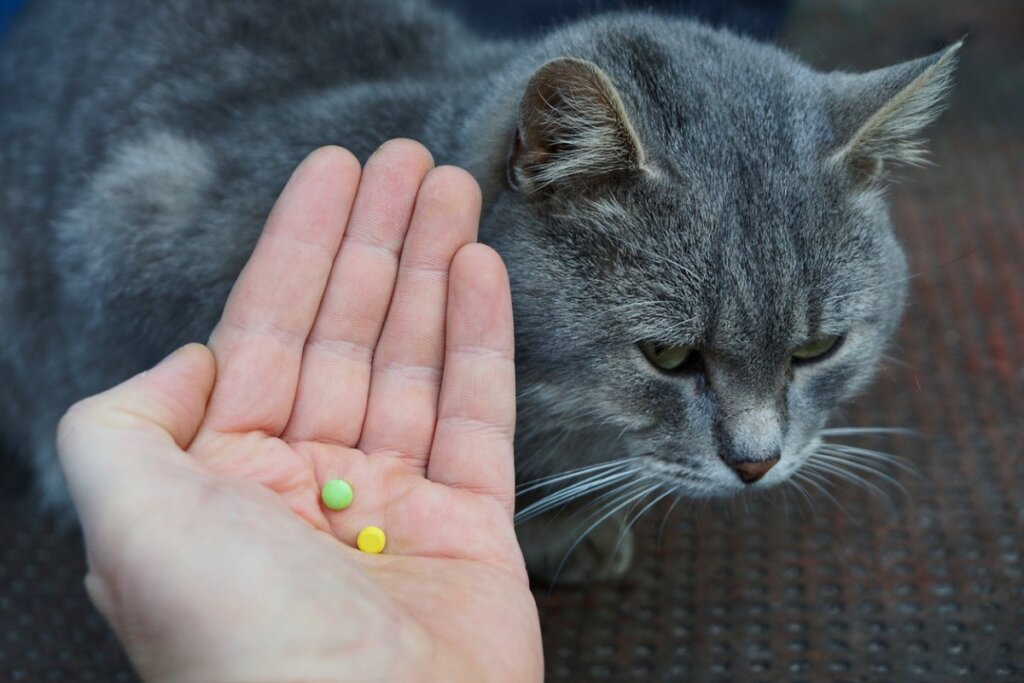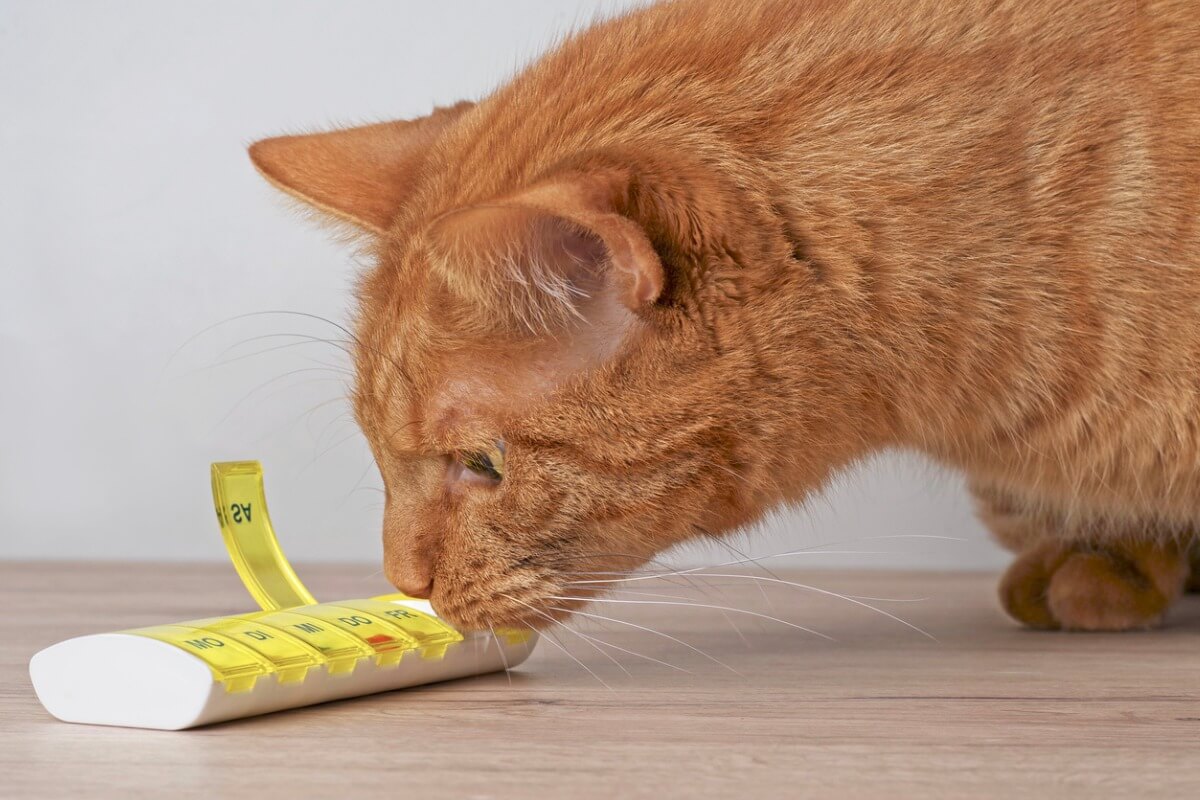Febantel for Cats: Dosage and Side Effects

If your cat has ever been treated for internal parasites, you may have heard of febantel for cats. This compound is usually prescribed along with other medications, also antiparasitic, such as praziquantel or pyrantel.
In this article, you can find a tab with all the basic information you need to know all about this drug, along with its properties and contraindications. Read on and find out more.
What is febantel for cats?
Febantel is an active ingredient that acts as a broad-spectrum antiparasitic, which means that it’s only effective for gastrointestinal and pulmonary nematodes and cestodes. It’s used in a variety of species, not only in cats, precisely because of this general effect on internal infestations.
Febantel is a probenzimidazole that’s metabolized in the liver. When it reaches the liver, it’s broken down into fenbendazole and oxfendazole, substances with anthelmintic capacity or, in other words, which are effective in eliminating worm-like parasites.
This drug doesn’t kill the parasites directly, but alters their digestive system by destroying the structural protein of the digestive system (tubulin). In this way, they end up dying because they can’t metabolize the nutrients they parasitize from their host. Febantel can’t be used as a preventive antiparasitic.

Uses of febantel for cats
Febantel is recommended in cases of infestation by hookworms (hookworms or uncinaria), roundworms (Toxocara cati in the case of the species in question), whipworms (Trichuris trichiura), or tapeworms. Generally, these parasites and their eggs are expelled through the feces, so they’re visible under the microscope.
Febantel doesn’t only attack adult parasites – it’s also effective against larvae and eggs.
Even though it won’t prevent future infestations, your veterinarian can include febantel in the deworming schedule. It’s most often prescribed in young cats and cats that have access to the outdoors, as it’s easier for them to become infected internal parasites.
How is febantel administered?
Febantel is always administered orally and after daily feeding. If the feline is difficult to handle, you can try to include the tablet in the food, although the animals tend to detect it easily.
Since febantel is only effective against parasites, it may be necessary to repeat the treatment if the cat is still at risk of reinfestation.
This compound is rapidly absorbed, reaching the bloodstream within 6 to 12 hours. If given during a meal, it remains in the stomach for some time, releasing slowly and increasing its time of effectiveness.
Dosage
Febantel for cats is available in tablet form and as an oral suspension. The dose is 10 milligrams per kilogram of animal weight for 3 days. The dosage calculation for each patient will be made by a veterinarian, as it depends on the weight of the animal, the stage of the infestation, and the administration of other medications.
The most common is that the veterinarian prescribes febantel along with other medications. The two most common are as follows:
- Praziquantel: Damages parasite tissues, like febantel, and inhibits their uptake of glucose to hasten their death.
- Pyrantel: This acts by immobilizing the parasite by blocking its nerve impulses.
Contraindications to febantel for cats
Febantel isn’t recommended for pregnant cats and kittens weighing less than one kilogram. However, this drug isn’t excreted through breast milk, so nursing cats can safely take it for their kittens.
Side effects
This drug is quite safe for cats and it takes 15 times the recommended dose to cause poisoning. In addition, it doesn’t produce interactions with other anthelmintic drugs that are usually prescribed in the same treatment.
In the case of excessive accidental ingestion, it’ll be possible to see symptoms of intoxication in the feline. The most common are the following:
- Excessive salivation
- Diarrhea
- Vomiting
- Loss of appetite
Never use febantel formats for dogs in cats. Although the active ingredient is the same, calculating the dosage is much more difficult and increases the risk of poisoning. In general, never medicate your cat without a veterinary prescription.
Precautions when using febantel for cats
This article is intended to inform, not to diagnose or provide treatment. In the event that you suspect your cat may be suffering from a parasitic infestation, the correct course of action is to visit your veterinarian.
Pay attention to the usual symptoms of parasitic infestation, such as diarrhea or weight loss. The animal will often continue to eat as normal (or even more) and still lose weight.

Most of these parasites can be easily prevented if you’re strict with the schedule of deworming and vaccinations. Although your cat can still catch an infection or disease (especially if they have access to the outside of the house), it will always be less frequent if their body is protected.
All cited sources were thoroughly reviewed by our team to ensure their quality, reliability, currency, and validity. The bibliography of this article was considered reliable and of academic or scientific accuracy.
- Vásquez Turriago, C. L. A. (2019). Protocolos de desparasitación de mascotas y percepción de propietarios frente al riesgo zoonótico en la ciudad de Bogotá. https://ciencia.lasalle.edu.co/. Recuperado 23 de noviembre de 2021, de https://ciencia.lasalle.edu.co/cgi/viewcontent.cgi?article=1082&context=maest_ciencias_veterinarias
- García Soto, M. (2014). Helmintos y protozoos gastrointestinales de gatos (Felis catus) de la ciudad de Santiago, Chile.
- Scorza, A. V., Radecki, S. V., & Lappin, M. R. (2006). Efficacy of a combination of febantel, pyrantel, and praziquantel for the treatment of kittens experimentally infected with Giardia species. Journal of feline medicine and surgery, 8(1), 7-13.